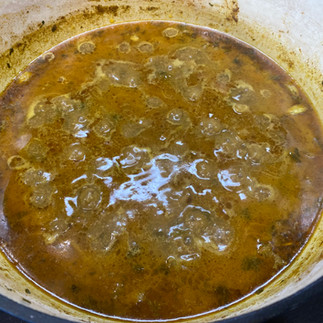Lamb Biryani
- Mike Grubb
- Sep 16
- 4 min read
Lamb biryani isn’t just a meal—it's an experience, layered with stories, aromas, and cultural connections. Whether you first encountered it at a festive family gathering or stumbled upon it during a spontaneous restaurant visit, this iconic dish leaves a lasting impression. But what exactly makes lamb biryani so beloved, and why does it continue to bring people together across the world? In this article, we’ll unlock the fascinating history, regional variations, preparation secrets, and cultural symbolism of lamb biryani, inviting you to savor every detail...Let's Get Cooking!

The Origins and Evolution of Biryani
Biryani’s roots can be traced back centuries, weaving through the bustling streets of South Asia and beyond. But how did lamb become such a key player in this cherished dish?
An Ancient Tale with Persian Influence
The term ‘biryani’ is believed to stem from the Persian words "birian" (fried before cooking) and "birinj" (rice).
Most historians agree that biryani traveled to the Indian subcontinent with Persian or Mughal influences around the late medieval period.
The use of lamb or mutton became prevalent in regions with an abundance of sheep rearing.
Lamb as a Choice Protein
In many South Asian cuisines, lamb offers a deep, earthy flavor that pairs perfectly with bold spices and fragrant rice.
Its rich taste and tender texture make it the preferred protein for special-occasion biryanis in regions from Hyderabad to Kashmir.
Regional Styles: Not All Lamb Biryani is Created Equal
While the heart of biryani remains rice, meat, and spices, methods and flavors diverge dramatically from one region to another.
Hyderabadi Lamb Biryani
Famed for its fiery aroma and complex layering, Hyderabadi biryani:
Uses the ‘kacchi’ (raw) method, where marinated lamb is layered with partially cooked rice and steamed together.
Features aromatic saffron, caramelized onions, and a medley of spices like cardamom, cloves, and bay leaves.
Often includes a handful of fresh mint and coriander for a burst of color and freshness.
Kolkata Lamb Biryani
A distinctly lighter, yet fragrant variation, Kolkata biryani:
Is marked by the unexpected inclusion of potatoes alongside lamb.
Originates from Nawab Wajid Ali Shah’s exile to Bengal, where local cooks adapted biryani to regional tastes and budgets.
Tends to be milder in spice, with a delicate balance of flavors and a touch of rosewater.
Lucknowi or Awadhi Lamb Biryani
Known for its subtlety and elegance, the Lucknowi version:
Relies on the ‘pakki’ (pre-cooked) method, cooking both meat and rice separately before layering.
Incorporates ingredients like kewra water and saffron for unique fragrance.
Prioritizes an even spice blend, placing emphasis on technique and presentation.
The Art and Science of Making Lamb Biryani at Home
Preparing lamb biryani can feel intimidating, but with patience and a bit of guidance, anyone can master this celebrated dish.
Key Steps to Success
Marinating the Lamb: Soaking lamb pieces in yogurt, ginger-garlic paste, and spices tenderizes the meat and infuses it with flavor.
Perfecting the Rice: Use fragrant basmati rice, rinsed and soaked, then parboiled until just tender to prevent mushy layers.
Layering: In a heavy-bottomed pot, alternate between spiced lamb mixture and rice. Each layer brings an interplay of textures and flavors.
Cooking: Seal the pot with dough or a tight lid and cook on low heat—this steams everything together and intensifies the aroma.
Essential Spices and Ingredients
Cardamom pods
Cloves
Bay leaves
Cumin seeds
Cinnamon sticks
Saffron strands soaked in warm milk
Fried onions
Fresh mint and coriander leaves
Common Pitfalls (and How to Dodge Them)
Overcooked Meat: Marinate thoroughly and don’t rush the process.
Sticky Rice: Remember, rice must be only 70% cooked before layering—it finishes steaming in the pot.
Insufficient Seasoning: Taste your marinade and rice for salt and spice before assembly.
Lamb Biryani Beyond the Plate: Culture, Festivities, and Family
It’s impossible to discuss lamb biryani without touching on the cherished memories it inspires. In many households, biryani isn’t simply dinner—it’s a centerpiece for celebrations, from weddings to Eid feasts.
Biryani in Modern Food Culture
An international staple: From London’s Brick Lane restaurants to New York’s food trucks, lamb biryani has found global fans.
Social media inspiration: The rise of video tutorials and food vlogs makes authentic biryani recipes more accessible than ever.
Fusion takes: Creative chefs have even experimented with biryani-inspired wraps, pies, and burgers.
Tips for the Perfect Biryani Feast
Want to throw your own biryani party or simply enjoy a special meal at home? Here’s a quick checklist:
Invest in good-quality basmati rice and fresh lamb.
Don’t skimp on marination time—it’s the foundation of flavor.
Use a thick-bottomed pot for even cooking and prevent burning.
Serve with classic sides like cucumber raita, mirchi ka salan (spicy chili curry), or a crisp salad.
Invite friends or family to help—it’s more fun when shared.
Lamb biryani is more than a delectable rice and meat concoction; it's a culinary tapestry, rich with history, technique, and emotion. From its royal roots to today’s family kitchens, every batch carries memories and meaning. If you’ve never tried making lamb biryani yourself, give it a shot—embrace the layers, savor the aromas, and cherish the company...Just Keep Cooking!
LAMB BIRYANI











































Comments